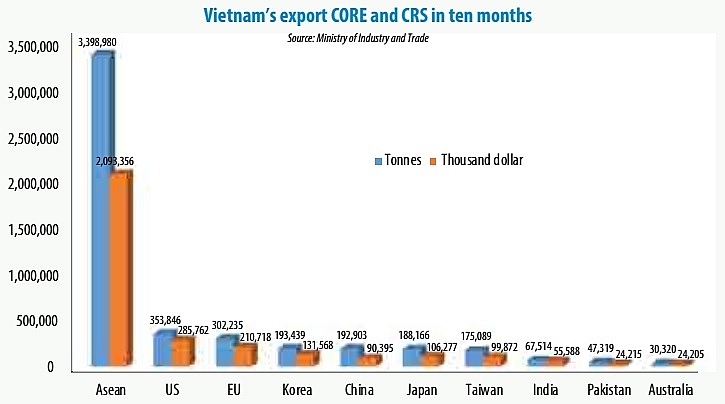Steel schemes set despite US duties
 |
The US Department of Commerce last week imposed duties of up to 456 per cent on certain steel products imported from Vietnam using South Korean- or Taiwanese-origin substrate. The steel products involved in the decision refer to corrosion-resistant steel products (CORE) and cold-rolled steel (CRS).
The move was no surprise for local steel-makers, with the United States previously applying anti-dumping duties of 531 per cent on Vietnamese-shipped CORE, and in 2017 duties of nearly 200 per cent were placed on galvanised items processed from Chinese steel. Vietnamese manufacturers had already, as a result, diversified material sources and witnessed government efforts to tighten the process in order to avoid illegal shipments.
While industry insiders shrugged at the move, saying it likely will not place much of an effect on Vietnamese steel-makers, it may even produce a windfall for Hung Nghiep Formosa Ha Tinh Steel Co., Ltd, operator of a $10.5 billion steel and port complex in the central province of Ha Tinh.
Formosa is the only producer of hot-rolled steel materials for CORE and CRS. According to a VIR source, Vietnam produced 4.5 million tonnes of this steel in 2019, mostly contributed by Formosa.
In a document from the Vietnam Steel Association, the suggestion was made that steel-makers should use material sources from Formosa, as well as from the Japanese or Brazilian market, in order to reduce the risks when exporting to the US. The US currently accounts for 6.5 per cent of Vietnam’s total steel exports, while the Southeast Asian market makes up for 65 per cent. Thus those using materials from Formosa and markets outside South Korea and Taiwan will not be subject to the US’ tariff.
The positive demand could be a driver for Formosa to start its third blast furnace construction soon, having previously considered construction delay due to concerns of a Chinese steel capacity glut. The group fired up its second blast furnace last year to bring Formosa’s total production capacity to 6.71 million tonnes of liquid cast iron annually, with sales estimated at $3.5 billion.
Formosa was licensed in 2008 with the registered capital of $2.7 billion. The company has since sought to have its investment certificate amended 14 times, gradually increasing the chartered capital. The company asked to raise its capital to $7.8 billion in 2012, and $10.5 billion following the latest adjustment in 2015.
Meanwhile, Hoa Phat Steel also last week furthered plans to start operations of the second phase of its Dung Quat steel plant in the first half of 2020, which will lift domestic availability of hot-rolled coil and put pressure on prices.
Total flat steel exports of Vietnam in 2019 up to October have contracted by nearly 20 per cent, compared with 9.8 per cent growth in the same period of 2018.
What the stars mean:
★ Poor ★ ★ Promising ★★★ Good ★★★★ Very good ★★★★★ Exceptional
Related Contents
Latest News
More News
- First members of Danang International Finance Centre revealed (December 22, 2025 | 17:39)
- Human-centred governance seen as key to AI development (December 19, 2025 | 18:19)
- Top 10 notable events of Vietnam’s industry and trade sector in 2025 (December 19, 2025 | 14:00)
- Tungsten surges to 12-year high as world enters a new 'black gold' race (December 18, 2025 | 17:27)
- Vietnam’s coffee exports set new record despite price pressures (December 18, 2025 | 17:13)
- Garment and textile sector seeks new growth after volatile year (December 18, 2025 | 17:01)
- VinSpeed and Siemens strengthen cooperation for high-speed rail development (December 18, 2025 | 16:53)
- High-tech adoption for TH true MILK (December 18, 2025 | 13:39)
- Takeda supports health resilience amid climate change challenges (December 18, 2025 | 12:39)
- Mondelez Kinh Do - a chapter of purpose-led leadership in Vietnam (December 18, 2025 | 09:44)

 Tag:
Tag:






















 Mobile Version
Mobile Version